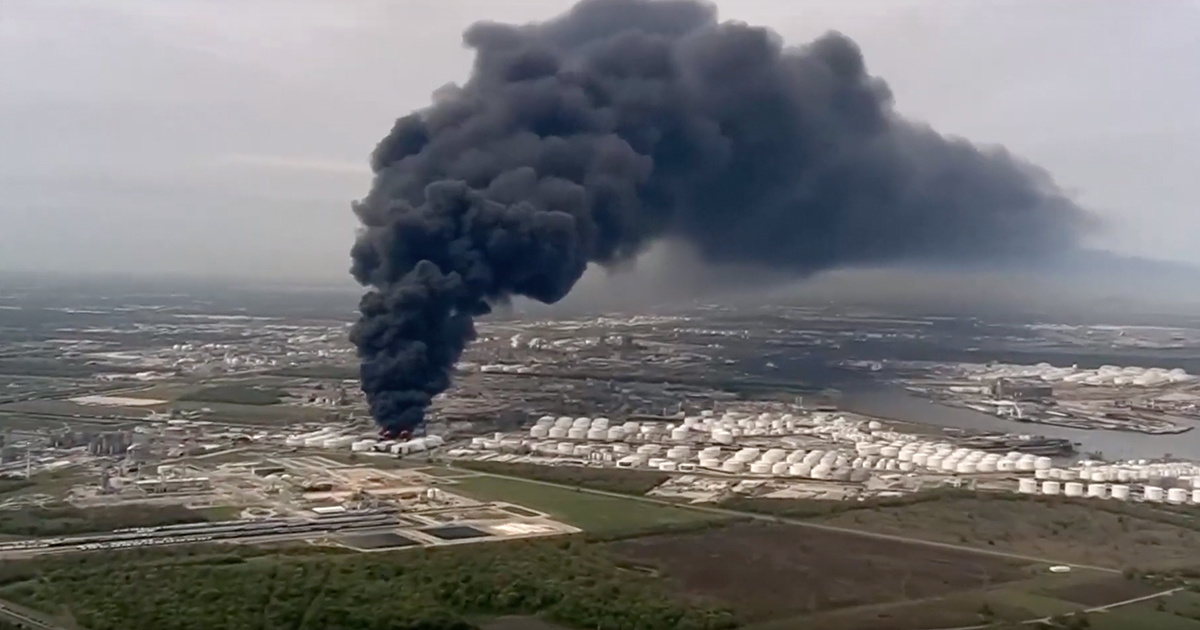
Fire Continues at Texas Petrochemical Plant as Company’s History of Violations Gets Renewed Scrutiny

A fire erupted Sunday at a petrochemical plant in Deer Park, Texas. NowThis News / YouTube screenshot
By Andrea Germanos
A petrochemical plant near Houston continued to burn for a second day on Monday, raising questions about the quality and safety of the air.
The Deer Park facility is owned by Intercontinental Terminals Company (ITC), which said the fire broke out at roughly 10:30 a.m. Sunday. Seven tanks are involved, the company said, and they contain naptha, xylene, “gas blend stocks” and “base oil.”
“It’s going to have to burn out at the tank,” Ray Russell, communications officer for Channel Industries Mutual Aid, which is aiding the response effort, said at a news conference. It could take “probably two days” for that to happen, he added.
PETROCHEMICAL FIRE IN TEXAS: A fire at a fuels storage company has spread to eight massive petrochemical storage tanks, shutting schools and forcing residents around Deer Park, Texas to stay indoors https://t.co/k4CWwLuUuY
— NowThis (@nowthisnews) March 18, 2019
ITC Terminal fire still throwing up a tremendous plume. Dominating the Houston skyline at dawn. pic.twitter.com/pMYTyoPB6O
— Tracy Hester (@tdhester) March 18, 2019
No injuries were immediately reported.
“Although the risk of explosion is minimal, we continue to take precautions to further reduce this possibility,” the company said in a statemnt.
An order to shelter in place for the city of Deer Park was lifted Monday morning.
Filming outside the plant on Monday, local ABC13 reporter Miya Shay said that despite the assertion by the city, informed by results from a private air monitoring contractor, that the air quality was safe, it is “hard to believe it’s all fine.”
I am at the ITC plant fire, where company officials insist the air quality is within limits. Fire May take two more days to burn out. Watch my video and you decide if it’s a problem. #ITCfire #deerparkfire #abc13 https://t.co/sSccL5omag pic.twitter.com/2WyOOcuw3x
— Miya Shay (@ABC13Miya) March 18, 2019
As Luke Metzger, executive director of Environment Texas, pointed out, “Intercontinental Terminals estimates the fire has already resulted in 3.1 million pounds of unauthorized emissions. That’s more than all the facilities in the Houston area put out during Harvey.”
What’s more, he said, the company “has a history of violations. For example, the company discharged cyanide into the impaired Tucker Creek eight times above permitted levels — once as high as 1138 percent above the permit.”
Intercontinental Terminals estimates the fire has already resulted in 3.1 million pounds of unauthorized emissions. That’s more than all the facilities in the Houston area put out during Harvey. https://t.co/yNvnBPAkzF
— Luke Metzger (@lukemetzger) March 18, 2019
Intercontinental Terminals Company, which has 8 tanks on fire right now, has a history of violations. For example, the company discharged cyanide in to the impaired Tucker Creek eight times above permitted levels – once as high as 1138% above the permit. https://t.co/ECr4ZIRNCb
— Luke Metzger (@lukemetzger) March 18, 2019
The Deer Park incident erupted just one day after a fire broke out roughly a dozen miles away at ExxonMobil‘s massive refinery in Baytown. That fire has been contained.
The Texas arm of advocacy group Public Citizen pointed to the recent incidents as evidence that the U.S. Environment Protection Agency and Texas Commission on Environmental Quality should do a better job at protecting public health:
In 2016, a @houstonchron investigation found a chemical incident in the Houston area every six weeks. We've seen two just in the past weekend alone.
It's time for @tceq and @epa to strengthen enforcement and protect public health.https://t.co/5qFrUXw4a7 #cleanuptceq
— Public Citizen Texas (@PublicCitizenTX) March 18, 2019
'Unseen dangers' of Harvey: Petrochemical plants release 1 million pounds of harmful air pollution. https://t.co/dE8abfrhrx
— EDF (@EnvDefenseFund) August 30, 2017
Reposted with permission from our media associate Common Dreams.

 233k
233k  41k
41k  Subscribe
Subscribe 